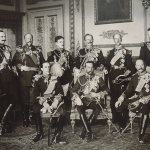The Bible is the sacred book of Christianity. There are many Christian churches, but all accept the two sections of it: the Hebrew scriptures, which we know as the Old Testament, and the Christian writings, known as the New Testament. Roman Catholics, among other Christian churches, accept a third section known as the Apocrypha. This was included in the Greek version of the Old Testament (the Septuagint).
Each section contains a number of separate books, composed at different times by different authors. This being said, most Christians consider them infused with divine authority.
There are 39 books in the Old Testament. The first five deal with ‘the Law’ (Torah or Pentateuch); they describe the origins of the Jewish people. The book of ‘The Prophets’ gives a history of the settlements in Canaan, the epoch of the Kingdom of Israel, and divers commentaries on both. ‘The Writings’ consist of the remained of the books including the Psalms, Job and Daniel. The final content of the Hebrew Old Testament dates from around 100 AD.
The New Testament consists of 27 books. The four Gospels (the word means ‘good news’) are attributed to Matthew, Mark, Luke and John, and they record the historical birth, life, death and resurrection of Jesus Christ. The Acts of the Apostles traces the development of the very early Christian Church. The Epistles (or ‘letters’), especially that of St. Paul, contain advice on worship, conduct, and organisaztion of the first Christian communities. The extraordinary Book of the Revelation (known by Catholics as ‘the Apocalipse’) was written by St. John the Divine, the only one of Christ’s followers known to be an intellectual. In this book the reader will find a probably accurate description of the end of the world.
Most of these books were seen as canonical, which means accepted as sacred and genuine, by the middle of the 2nd century. The Apocrypha (hidden things) is the collection of 12 books written between 300 BC and 100 AD. They were included in the Septuagint, which was a Greek translation of the Old Testament of the third and second centuries BC. It was used by the early Christian Church, but the books do not appear in the Hebrew Old Testament. Neither are they accepted by all Christian churches.
The Bible was originally written in Hebrew, Aramaic and Greek, ancient languages with their own syntax, grammar and extensive literature. The film director Mel Gibson chose Aramaic as the language to be used by the actors in his film of the final sufferings of Christ, The Passion.
The first translation of both testaments was the Vulgate (in Latin) 405 AD, of St. Jerome. The first translation into English was by John Wycliff and his students between 1382 and 1388. Subsequent development of printing stimulated the production of later editions in the vernacular. Martin Luther translated the New Testament into German in 1522, and William Tyndale into English during 1525 and 1526. Coverdale’s edition of both testaments, which drew mightily on Tyndale’s work, was first published in 1335, and revised as the Great Bible in 1339.
The Authorized or King James Version (1611) was named after King James I of England (and VI of Scotland). He had agreed to a new translation at the Hampton Court Conference. It was composed by around 50 scholars and remained as the standard version of the Bible in every English-speaking country for centuries afterwards.
This year we are celbrating the 400th anniversary of the King James or Authorized Version of the Bible. There are differences of opinion among intellectuals about the actual influence of the Authorized Version on English speaking and literature. The historian Macaulay once said that if every other book perished the Bible ‘would alone suffice to show the whole extent’ of the beauty and pwer of the English language. But Macaulay’s own glorious style of prose contained frequent use of the subordinate clause, which does not exist in the translation made in King James’ reign. The ‘James’ follows the structure of Hebrew, with sentences piled up up on each other instead of involuted clauses, which suits English admirably. This is certainly why we find the Authorized Version so poetic. It is possible too that English readers like the archaisms found on every page of the AV.
Another complaint of the intellectuals is that because of its restricted vocabulary, the AV is not always easy to understand. Listen to this obscurity from Ezekiel 13:18 – “Woe to the women that sew pillows to all armholes, and make kerchiefs upon the head of every stature to hunt souls”. Eh, yes but what does it mean? Perhaps the problem comes from the obscurity of the practices described? Some kind of explanation is required, and the AV does not provide it. By comparison, the Spanish version of the Bible speaks of women who tejen ligaduras mágicas – ‘weave magic bands to bind people’s hands’. Thanks to Spanish, the passage become clear.
The beauty of the King James Version remains unsullied, but imagine our difficulty if we spoke as it spake! It is true that we speak the same language, but this is the language used by the almost totally unread and unreadable Langland, and the at times impenetrable Chaucer and Shakespeare. Nevertheless, perhaps 250 phrases used in our daily language come from the Authorized Version, such as ‘salt of the earth’ and ‘from strength to strength’. This and more has been established in scholarly works like David Crystal’s book Begat.
Notwithstanding, newer translations, like the New English Bible (1970) are much overused in the Church of England. They make a nonsense of what by tradition we are accustomed to in our Bible reading (if we ever bother to open one). For example, the spellbinding opening verses of the Gospel of St. John the Divine (‘In the beginning was the Word, and the word was with God, and the word was God/The same was in the beginning with God/All things were made by him; and without him was not anything made that was made/In him was life; and the life was the light of man/And the light shineth in darkness; and the darkness comprehended it not’ etc.) are changed in all modern bibles into facile modern guff that make an English scholar weep.
There are now translations of all or part of the Bible in nearly 2000 languages.
Dean Swift










Leave A Comment